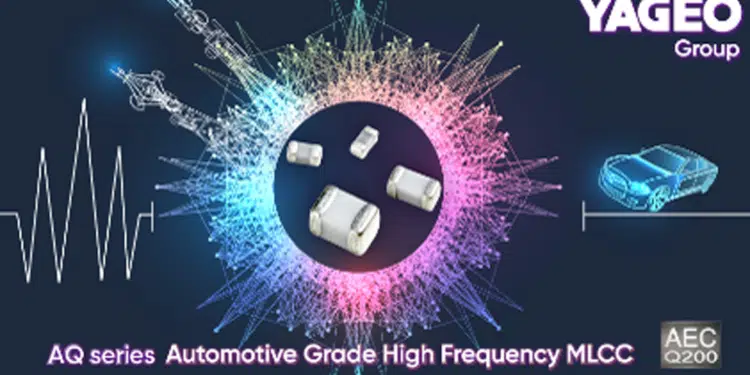YAGEO Group, the global leading passive component service provider, has extended the product range of automotive grade high frequency MLCC, AQ series, with temperature stable NPO dielectrics. In addition to 0603 0.2pF ~ 100pF with 50V rated voltage, which was launched more than a year ago, now 0402 0.1pF ~ 100pF with 50V rated voltage is available in mass production.
Featuring excellent temperature characteristics and a narrow tolerance of capacitance, YAGEO’s AQ series capacitors apply in-house concepts in both material and processing designs. The development demonstrates YAGEO’s leading position in innovation and R&D, as well as the firm commitment to meeting customer’s needs.
Features
- HiQ, low ESR, low ESL, and high SRF in VHF, UHF and microwave frequency bands
- BME process with copper inner electrodes
- Tight tolerance (min. ±0.05pF) of capacitance
- AEC-Q200 qualified and PPAP provided
- 100% AOI & SPC monitor
High-Q capacitors, also known as high quality factor capacitors, provide high quality factor (low dielectric loss), low power dissipation, and better efficiency than standard MLCCs. The AQ series high frequency MLCCs are typically used in applications with high frequencies from 500MHz to 10GHz. With improved low power consumption for mobile telecommunications, the AQ series has copper inner electrodes that allow for low ESR (Equivalent Serial Resistance), low ESL (Equivalent Serial Inductance), and high SRF (Self Resonant Frequency) in UHF (300MHz-3GHz), SHF(3GHz-30GHz) and microwave frequency bands. They are ideal for high frequency applications such as impedance matching, decoupling, and resonance circuits.
Just like YAGEO’s other automotive grade MLCCs AC and AS, YAGEO treats AEC-Q200 criteria as the basic quality requirements for its AQ series MLCC. To reach even higher quality level, longer life, and more superior reliability, the approaches including high quality raw material, advanced and dedicated production line, tightened processing control, and entire in line and outgoing automatic check are adopted on top of the existing production standards.
Production part approval process (PPAP) documents are ready for AQ series items. As all other Yageo’s MLCC series, AQ series is RoHS compliant too and with improved thermal and mechanical robustness. This offers customers a wider variety of choices and solutions in order to meet various application demands and requirements.
































